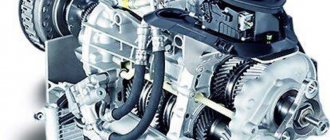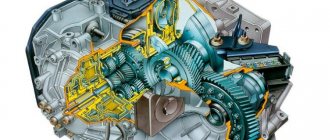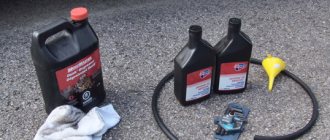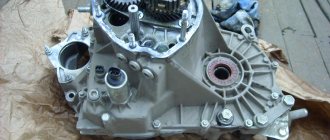In order to avoid the need to make premature, expensive transmission repairs, the automatic transmission especially needs timely and high-quality maintenance. At the same time, SUVs and crossovers, even taking into account their apparent strength and reliability, are no exception.
As for the popular Volkswagen Touareg model, it is necessary to carry out a complete or partial oil change in the Touareg automatic transmission on time. At the same time, it is not always necessary to contact a car service, since this procedure can be performed independently. Let's look at this issue in more detail.
Oil life
The Volkswagen Touareg is equipped with a 09D transmission. It was also installed on crossovers from Audi. In the operating manual, the manufacturer does not indicate after what period the oil in the box should be changed. They say it is filled for its entire service life. Perhaps this is true for Germany, because the Germans use the car for up to 100-150 thousand kilometers. But our realities are significantly different. So, you can often find a Volkswagen Touareg with a mileage of 400 thousand kilometers. Of course, in order for the car to survive until this period, you need to change consumables in it, including changing the oil in the automatic transmission. In our conditions, the Volkswagen Touareg requires this operation once every 60 thousand kilometers. This is exactly the regulation that most experts have determined.
You need to understand that oil is the working fluid in an automatic transmission. In addition to its main function (lubrication), it performs:
- Heat removal.
- Reducing the mechanical load on automatic transmission elements.
- Removal of small particles that are formed as a result of wear of components.
Over time, this liquid becomes black (initially red). This indicates that an urgent oil change is required for the Tuareg automatic transmission. Whether it's a 2.5-liter engine or a 3-liter engine doesn't matter. Driving with such ATP fluid is fraught with unexpected breakdowns.
What kind of oil to fill in the automatic transmission of Volkswagen Touareg 3.0 TDI
The three-liter Volkswagen Touareg engines were accompanied by both six-speed and eight-speed automatic transmissions. Everything directly depends on the year of manufacture of a particular model. So the six-speed can be seen on first-generation Tuaregs in the GP body with diesel engines:
- 3.0 l, 224 hp
- 3.0 l, 240 hp
- 3.0 l, 225 hp
In addition, it is also present on models with engines:
- 2.5 l, 163 hp
- 2.5 l, 174 hp
- 3.2 l, 220 hp
- 3.2 l, 241 hp
- 3.6 l, 280 hp
- 4.2 l, 310 hp
- 5.0 l, 313 hp
- 6.0 l, 450 hp
Eight-speed hydromechanics have been installed on three-liter Tuaregs since 2010, in NF, FL and CR bodies:
- 3.0 l, 204 hp
- 3.0 l, 245 hp
- 3.0 l, 249 hp
- 3.0 l, 333 hp
- 3.0 l, 340 hp
It was also installed with motors:
- 2.0 l, 249 hp
- 3.6 l, 249 hp
- 3.6 l, 280 hp
- 4.1 l, 340 hp
- 4.2 l, 360 hp
As for the transmission fluid, the manufacturer uses its own original VAG ATF G055025A2 transmission oil in these machines. However, many motorists resort to using the less expensive analogue of the Toyota TIV.
| VAG ATF oil G055025A2 - 1600 rub. | Toyota ATF T-IV oil - 700 rub. |
What to choose?
To change the oil in the automatic transmission of a diesel Tuareg 3.0, an original fluid with index G 055 025 A2 is required. But the problem is that only officials have this oil and it costs about three thousand rubles per liter.
What then should I use to change the oil in the Tuarega 3.0 automatic transmission? You can use an analogue from Mobile or DuraDrive MV. These products meet all tolerances. They are suitable not only for changing the oil in the automatic transmission of a diesel Tuareg 2.5, but also for gasoline engines. The cost of one liter of product is about 700 rubles. How much oil is required for changing? It all depends on the method of operation. If this is a partial replacement, you need to prepare about four liters. A complete oil change in the Tuarega 3.6 automatic transmission requires at least nine liters. Next we will look at the features of each method.
Let's sum it up
As you can see, changing the oil in a Tuareg automatic transmission (at least partially) is not a very complicated operation; it also does not require special skills or special equipment. The only problem is that to achieve maximum oil renewal, the procedure must be repeated several times at short intervals, which means high overall transmission oil consumption.
Simply put, in some cases you can limit yourself to only a major overhaul of the automatic transmission (without replacing most of the parts), that is, to avoid costly overhaul of the gearbox or replacing the automatic transmission with a contract copy.
Partial oil change in Tuarega automatic transmission
The essence of this operation is that the old oil is replaced with a new one. But it is only half replaced, since no more than 50 percent of the filling volume can come out of the box. Thus, this replacement is resorted to more often than a complete one. That is, such an operation needs to be performed once every 30 thousand kilometers.
So, how is a partial oil change performed in a Tuareg automatic transmission? To do this, you first need to install the car on the inspection hole. Next, the standard engine mudguard is removed. The car is installed on the handbrake. In this case, the gearshift lever should be in “Parking” mode.
Please note that changing the oil in the Tuareg automatic transmission is carried out only after the box has warmed up. To do this, start the engine and warm up to approximately 50 degrees Celsius. Then you can turn it off and go under the car. Using a hex wrench, you need to unscrew the drain plug. An empty container with a volume of at least three liters is first prepared. It can be made from an old plastic canister.
It is important to remember that the engine should not be started until there is new oil in the box. Without it, the automatic transmission will simply fail (exactly the same as if an internal combustion engine were running without oil). When the liquid is completely drained, the drain plug is screwed back on. Typically the container holds about three liters. Next, you should find the seal and fill in new fluid through the oil filler tube. Its volume should be equal to the amount of the old one - no more and no less.
Checking the level
The automatic transmission does not have a dipstick. Therefore, to check the oil level in the Tuareg automatic transmission, you will need to unscrew the control plug from the bottom of the pan. But first, you will need to warm up the automatic transmission.
- Warm up the Touareg automatic transmission.
- Drive the car for five kilometers so that the oil spreads over the most inaccessible parts of the machine. This is done if the car has been standing for a long time. If you use it often, then it will be enough to warm up the machine to 50 degrees.
- Place the Touareg on a flat surface.
- Do not turn off the engine. Get under the car.
- Unscrew the control plug on the pan
Oil should drip out of the hole. Don't forget to place a container for drainage so as not to contaminate the soil. If there is no oil, then you need to add it from a syringe into the box. The topping procedure is carried out until oil flows out of the control hole.
Pay attention to the color and impurities in the automatic transmission lubricant. If it has darkened and looks like a suspension, then the lubricant in the Volkswagen Touareg needs to be replaced.
What's next?
Then you should start the engine and test all positions of the automatic transmission selector, while keeping your foot on the brake pedal. This way we will circulate new oil through the system. It would also be a good idea to check the oil level. In an automatic transmission, you need to do the check with the engine running. By taking out the dipstick, we will determine whether fluid needs to be added. Ideally, the oil should be in the middle, between o and “maximum”.
If the level is in order, you can put back the protective mudguard and begin full operation of the car.
Useful information for future Touareg owners
After re-reading my review, I decided that I should add some useful information about the car for future owners or those who are still looking! We will talk about the Tuareg before restyling (2002-2006), 3.2 petrol engine, spring suspension.
Before buying, as usual, we go for diagnostics to a service center, preferably specialized in VAG, and look:
1) the chassis completely and very carefully: steering rods, bushings, levers, silent blocks, struts, brake hoses, brake discs, pads, steering rack (knocking or not knocking).
at prices:
pads from 2300 + sensors 300 each
brake discs from 4000 (normal)
steering rods (come complete with ends) 1500 each
bushenki up to about 1000
only the lower front levers are replaced entirely and cost 4200 rubles, for the rest of the levers there are only silent blocks for 600 rubles each, but there are quite a few of them)
brake hoses 2000r
steering rack from RUB 25,000
2) further: look at the condition of the attachment belt, the presence of extraneous noise, inspect for oil leaks, inspect the transfer case for oil leaks (meaning greasy shanks), check the oil level in the transfer case and gearboxes (front, rear), inspect the thermostat and radiator for subject to cracks and coolant leaks, measurement of brake density. liquids and antifreeze to determine their suitability or unsuitability for further use.
Also, when checking the oil level in gearboxes, it is necessary to inspect the oil itself for chips; if any, the gearbox will need to be repaired.
at prices:
hanging belt RUB 2500
transfer case shank oil seal 1200
thermostat with housing and sensor 4500
radiator double the cheapest 8000
gearbox repair 20000
3) Automatic transmission: to rest. Tuaregs have a problem called a hydraulic unit or an automatic transmission valve block. To diagnose a malfunction, you only need one thing: a good drive of the car. The valve body will manifest itself when the box is heated, shocks will appear (very strong) when switching to a lower gear, or during sharp acceleration. In winter, for example, these shocks do not happen on my car (apparently the automatic transmission does not heat up so much in cold weather), only in the warm season. The oil level in the automatic transmission, as well as its condition, can only be checked when the car has cooled down to 32 degrees, there is no other way, there is no automatic transmission oil dipstick. A complete oil change in an automatic transmission using a machine is strictly prohibited; it can damage the box. Only a partial replacement with a filter (drained and refilled). The level, again, is set only at a certain temperature, nothing else.
You can throw tomatoes at me, but the box is the only thing in the car that is Japanese AISIN, and then they say that the Germans are trashy)))
at prices: Valve block 50-60 thousand, oil 1000 rubles liter original, if you don’t change the valve body and just change the oil in the automatic transmission 14-15 thousand for everything about everything including work.
4) ICE: unscrew the spark plugs, look at their condition (white stripes will mean misfires), misfires can mean either the spark plugs are bad or the ignition coils are bad, again, if it’s from the evil one, you can just put your hand on the engine and you’ll understand exactly whether it works or adjusts.
For example, a situation: you are driving with a seller, there is a sharp acceleration, you feel the car twitching + the check mark starts blinking = connect the scanner, look for gaps, and then solve the problem:
4.1) we put the swearing coils from other cylinders and repeat the operation with a sharp start, then we look at the computer and if it swears again at the same coils as the first time, then it’s the coils, and if it swears at the new ones, it means replacement spark plugs and coils don't touch.
4.2) you can change all the coils and all the spark plugs if your budget allows.
From personal experience, so that Americans don’t swear at gasoline, we use 98 in the summer and 92 in the winter.
at prices:
candles 450 R each there are 6 pieces
coil 2100 there are also 6 of them)
5) ICE chain. This feature in the engine scares many people, because everyone is so used to dealing with timing belts.
When driving quietly without sudden accelerations, the chain runs for a long time, there is data about 300 thousand km, the average figure is 150-200 thousand. It is very easy to check the chain stretch; this is done by computer; the indicators of groups 208 and 209 are looked at. A normal diagnostician will not keep you waiting for a verdict on the condition of the circuit.
at prices: a simple replacement without phase shifters is 50-60 thousand rubles, but if the repair is more serious then 80-100 thousand.
6) Electrics. We start with the interior lighting, central locking on/off, heater, air conditioning, heated steering wheel, we look to see if the tire pressure sensors are complaining, the sunroof is open-closed, the low-beam fog lights are on. everything everything everything should work!!!!! We turn on all transfer modes. We connect the computer and look for errors (we erase if there are any, then we start it, ride and look again with the computer)
If he swears at the tire pressure sensors, you can turn them off with a computer, if the heater motor rustles - 5 thousand for repairs, a standard xenon low beam lamp costs from 2 to 4 thousand apiece.
7) Vehicle software. On the car, you need to check the software version of the automatic transmission and internal combustion engine, cars from Germany will be gladly accepted by Official dealers and will update your programs, updates are necessary!! The Americans were left deprived and they don’t update us, you can only do this yourself by downloading the program and having a VAG cord (I haven’t bothered with this topic yet) All updates optimize the operation of the automatic transmission and internal combustion engine in tandem, you will feel the difference immediately. (so they say)
 Fuel system! namely fuel pumps, there are 2 of them. Usually by 200 thousand they need to be replaced. The car will simply stop moving, and with a sharp start it will “choke.” Diagnosis is very simple, take a hose from each pump in turn and for 30 seconds watch how much gasoline each pump pumps. If at least one pump does not pump to its full capacity, we replace both pumps!!! Only both!!! I changed one at a time which I regret
Fuel system! namely fuel pumps, there are 2 of them. Usually by 200 thousand they need to be replaced. The car will simply stop moving, and with a sharp start it will “choke.” Diagnosis is very simple, take a hose from each pump in turn and for 30 seconds watch how much gasoline each pump pumps. If at least one pump does not pump to its full capacity, we replace both pumps!!! Only both!!! I changed one at a time which I regret
at prices: approximately 12 thousand each pump
9) engine oil pressure
We connect a mechanical sensor and check the pressure. If it’s normal, everything is ok, if there are no options, there are plenty. (bad oil, non-original oil filter, dead oil pump, clogged channels, replacement of liners)
10) suspension bearing. We drive 40-60 km per hour and a terrible vibration begins. If the seller starts singing a song about balancing and so on, don’t believe it! With a bent steering rod and completely out of balance, there will be no vibration at this speed (personal experience)
Options 2:
10.1 replacement of the outboard bearing (maximum 5-7 thousand rubles)
10.2. replacement of the cardan assembly (several thousand dollars)
11) body. take a thickness gauge and look at all the body parts. (Painted bumpers are not scary!) The main thing is the doors, roof, hood.
12) Battery. You don’t need to diagnose it, just install a new one and forget it.
100 A 7-10 thousand rubles, located under the driver’s seat, emergency terminals for lighting are located under the hood on the driver’s side. Replacing a battery is a very interesting task, I advise you to entrust it to the experts and see for yourself from the outside)
Fuel consumption in winter 25 city, in summer 20 city, highway 10-12-13-16 (90 km, 100 km, 120 km, 160 km) do not believe in fairy tales about 15 liters in the city. I pour oil according to tolerances LM 5-50, or Mobile 5-50. antifreeze red Motul, transfer case/gearbox Mobile.
This is how the picture turned out! I described all my knowledge about the car I dearly love (without irony)!!!! You can print out the text and feel free to go and diagnose your future Tuareg!!!
The pleasure of driving is worth keeping your car in good condition, it’s also worth noting the cross-country ability - in winter I can park in any snowdrift with acceleration (I’m not afraid of the 1 cm steel crankcase protection + front arch), and then I also drive out of it without any problems !!
Thank you for your attention, I wrote for a very long time, edited a lot, it seems I didn’t miss anything.
Complete replacement
This method is slightly different. Here the oil is changed in full. But to do this, you need a special apparatus that, under pressure, will replace the old liquid with a new one. Without this equipment, a complete replacement cannot be performed. Therefore, this operation is performed only in the service. But experts note that this is a better and more correct method.
How is this operation performed? First, the car is driven into the box and placed on a lift. Next, specialists dismantle the automatic transmission pan, after draining the oil. Then the pan is cleaned of all dirt and wear products. Next, the element is installed in place. Then the device is connected to the pipelines that go to the oil cooling radiator. The device has already been filled with new fluid in full. It must be said that its quantity is slightly larger than the filling volume, about two liters.
At the next stage, the engine and the connected device start. Old fluid will flow out of one outlet, and new fluid will flow into the other. You can determine the condition of the oil by its color. When the liquid on both terminals is red, this indicates a successful oil change. In total, the procedure takes no more than an hour.
What if you don't change?
Experts do not recommend ignoring oil changes in the automatic transmission of the Volkswagen-Tuareg crossover for several reasons. Firstly, the old liquid is not able to remove heat properly. This increases the risk of the box overheating. Secondly, such oil cannot provide high-quality lubrication of automatic transmission elements, which leads to increased wear. And finally, the liquid itself is highly saturated with wear products. As a result, it works like an abrasive, creating a sandblasting effect under pressure. As a result, the valve body and control valves suffer. And the oil itself is saturated with aluminum dust.
All this, of course, is reflected in the car’s behavior. So, the driver notices strange vibrations and shocks that occur both while driving and while standing at idle. The transmission may jerk or slip when trying to switch to another gear.
Pallet installation
Wash and degrease the tray
Number of the original pan gasket
We put on the gasket and put the magnets in place
Carefully scrape off any remaining dirt from the gasket sealing box; it is convenient to use a utility knife for this. When cleaning the surface, you must try not to scratch it.
Degrease the surface of the box
Be sure to install a new o-ring on the fuel filter
When installing the filter, you must ensure that the sealing ring is installed correctly. If installed incorrectly, air leaks will form at the junction of the filter and the box and further failure will occur. Due to oil starvation of rubbing parts, speed packages fail. And as a result, expensive repairs.
The filter bolts should be tightened evenly. First you need to screw it all the way, and then tighten it by turning the key a quarter
We put the lid on, tighten the drain hole with a T-40 asterisk. When tightening the pan, it is not possible to damage the sealing gasket since it contains iron posts with holes for bolts.
Changing the oil in the automatic transmission of a Lada Granta: how to change the transmission fluid correctly
We insert the hose tightly into the filler hole, and insert the hose into the neck of the oil canister at the other end, cutting out the bottom. Using the law of communicating vessels, add oil. Since the hole in the breather box is too small, and to speed up the entry of oil into the box, you can insert a smaller diameter hose inside the filler hose to remove excess air.
When the oil is filled, you need to start the car and let it run for a few minutes, then move the automatic transmission with the selector handle sequentially to all selector positions for 10 - 15 seconds. At the right level. Oil will drip a little from the hole. That's it, the plug can be wrapped, but don't forget to change the sealing ring.
The tightening force for the oil level plug is 70 N/m.
After the automatic transmission has warmed up, it is necessary to inspect all connection points for leaks.
Good luck with your DIY repairs!
Please enable JavaScript to view the comments powered by Disqus.
Keep an eye on the level
No matter how long ago the replacement was made, it is necessary to periodically monitor the fluid level in the box. Due to its insufficient volume, various malfunctions may occur, as well as overheating of the automatic transmission. The clutches do not press well against the metal discs and slip. As a result, their temperature increases. The friction clutches become charred and destroyed. This also affects the oil itself. It acquires a black color and a characteristic burning smell.
What other problems are encountered when operating a Volkswagen-Tuareg automatic transmission with a low oil level:
- The thrust discs, rubber-coated pistons and clutch drum overheat.
- The hydraulic unit is wearing out.
- The hydraulic plate channels and plungers become clogged with mechanical particles caused by overheating. This entails increased wear of the rubbing elements of the pump and bushings.
Timely replacement of this fluid will avoid these breakdowns and extend the life of the automatic transmission.
Automaker and automatic transmission manufacturer - different views
Volkswagen claims that ATF is irreplaceable, and this is good advertising for the car. And in fact, the 0C8 automatic transmission is a very high-quality, technologically advanced product, the performance characteristics of which are likely to more than cover the warranty period.
The manufacturer, Aisin, claims that you need to keep an eye on the oil and change it regularly (every 20,000 miles) and the transmission will continue to work even after the warranty period expires.











